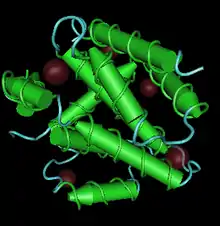| Alcelaphine gammaherpesvirus 2 | |
|---|---|
 | |
| 3D NIH Image of typical structure of Alcelaphine gammaherpesvirus | |
| Virus classification | |
| (unranked): | Virus |
| Realm: | Duplodnaviria |
| Kingdom: | Heunggongvirae |
| Phylum: | Peploviricota |
| Class: | Herviviricetes |
| Order: | Herpesvirales |
| Family: | Orthoherpesviridae |
| Genus: | Macavirus |
| Species: | Alcelaphine gammaherpesvirus 2 |
Alcelaphine gammaherpesvirus 2 (AlHV-2) is a species of Macavirus that is believed to be responsible for causing hartebeest infections of malignant catarrhal fever.[1]
Clinical definition
Distantly related to human herpes, a virus of this type is composed of a series of double strand sequences of up to 100 gene segments, aligned along a long chromosome surrounded by terminal DNA segments. The effect of the virus is to cause nasal discharge, a high fever, filmed over eyes, failures of the lymphatic system, inflammation of various mucous membranes, and occasionally necrosis of the upper digestive system. Very advanced cases show signs of decay of the nervous system. Occasionally, lesions, arthritis, and digestive problems such as diarrhea have been observed.[2]
Cause
The agent of MCF in hartebeests, it is related to other variants that strike down antelopes. It was isolated in 1960 and is believed to be carried as reservoirs by goats, sheep, and other domestic animals. There are variants that have affected deer, gnu, and other captive species in zoos around the world.
Range
All species of African wildebeest and hartbeest can be infected or at least carry this virus.[3] There is no direct evidence that other African wild variants like addax can be hosts, but research is ongoing.[4] The alcelaphine antelope affecting form is primarily found in Africa, in the natural habitat of wildebeest, hartebeest, and topi.[5] It has also occurred in zoos and wild animal parks that also kept wildebeest. The increasing popularity in North America of wild animal parks may spread its range further.
Transmission, clinical effects, and morbidity
Alcelaphine herpesvirus 2 is primarily transmitted by nasal emissions, by contact with water, flood, feces, or close contact. It can be destroyed by prolonged exposure to sunlight, but has a very long incubation period and thus may have a long period of time to infect other animals. There are three forms usually seen. The first a nasal form with fever, nasal inflammation and digestive problems that is very mild and only lasts a few days. The second is a more severe form that involves fever, diarrhea, heavy nasal discharge, and lymph system failure, with a morbidity of 28 percent. The so-called "head and eye" form is the most lethal and serious form, which results in all known effects and central nervous system damage, predated by nervous shakes and eventually muscular failure. Morbidity in some cases is as high as 90 percent.
Vaccination
As the primary infected strains of animals are wild and free range animals, vaccination programs have been largely ineffective.
References
- ↑ Fauquet, C; Maniloff, J.; Desselberger, U.; Ball, L.A. (2005). Virus Taxonomy: Classification and Nomenclature of Viruses : Eighth Report of the International Committee on the Taxonomy of Viruses. Academic Press. ISBN 978-0-12-249951-7.
- ↑ Adams, S.W.; Mutt, LM. (1990). "Characterization of envelope proteins of alcelaphine herpesvirus 1 & 2". Journal of Virology. 64 (7): 3382–3390. PMC 249586. PMID 2352327.
- ↑ Katz, Jonathan; et al. (1991). "Molecular diagnosis of alcelaphine herpesvirus (malignant catarrhal fever) infections by nested amplification of viral DNA in bovine blood buffy coat specimens". Journal of Veterinary Diagnostic Investigation. 3 (3): 193–198. doi:10.1177/104063879100300301. PMID 1911989.
- ↑ T. Vikoren; H. Li; A. Lillehaug; C. M. Jonassen; I. Bockerman; K. Handeland (October 1, 2006). "Malignant catarrhal fever in free-ranging cervids associated with OVHV-2 and CPHV-2 DNA". J. Wildl. Dis. 42 (4): 797–807. doi:10.7589/0090-3558-42.4.797. PMID 17255446.
- ↑ Klieforth, Robert; Maalouf, Gabriel; Stalis, Ilse; Terio, Karen (September 2002). "Malignant Catarrhal Fever-Like Disease in Barbary Red Deer (Cervus elaphus barbarus) Naturally Infected with a Virus Resembling Alcelaphine Herpesvirus 2". Journal of Clinical Microbiology. 40 (9): 3381–3390. doi:10.1128/jcm.40.9.3381-3390.2002. PMC 130662. PMID 12202582.